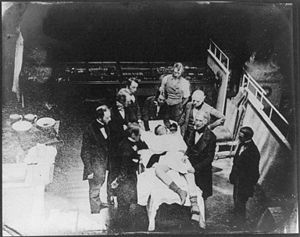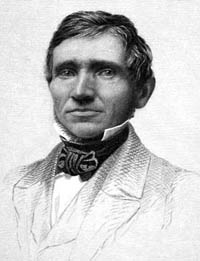Who discovered anesthesia? Surely, no one man can take the full credit. But some have tried. The history of anesthesia is a tangled mess full of men who wanted the recognition and riches for its discovery.
 Horace Wells first witnessed the effects of laughing gas in 1844 when it was given to him by a member of a traveling circus. He would then become the first patient to be operated on under anesthesia. He had a tooth pulled by an associate. He later began using the gas on his own dental patients. He never attempted to patent the procedure because he believed the pain relief should be available to all.
Horace Wells first witnessed the effects of laughing gas in 1844 when it was given to him by a member of a traveling circus. He would then become the first patient to be operated on under anesthesia. He had a tooth pulled by an associate. He later began using the gas on his own dental patients. He never attempted to patent the procedure because he believed the pain relief should be available to all.
In 1845, Wells gave a demonstration of the use of nitrous oxide during a tooth extraction to students at Massachusetts General Hospital. Unfortunately, the patient made a sound which was thought to be from pain. The procedure was deemed a failure and the students left the surgery chanting “Humbug! Humbug!” Wells was humiliated. Continue reading “Invention of Anesthesia Dispute”



 Chester Greenwood was an avid ice skater who lived in bitterly cold Maine. He attempted to keep his ears warm while skating using a scarf. But the bulky and itchy scarf he wrapped around his ears was unsuccessful. He needed to find a better way to stay warm while skating. At the age of 15, he made two circular hoops from wire and asked his grandmother to sew beaver fur and velvet on them. He held his two fur covered loops together with a steel band that created a headband. His new contraption was more much successful in keeping his ears warm.
Chester Greenwood was an avid ice skater who lived in bitterly cold Maine. He attempted to keep his ears warm while skating using a scarf. But the bulky and itchy scarf he wrapped around his ears was unsuccessful. He needed to find a better way to stay warm while skating. At the age of 15, he made two circular hoops from wire and asked his grandmother to sew beaver fur and velvet on them. He held his two fur covered loops together with a steel band that created a headband. His new contraption was more much successful in keeping his ears warm.
 Charles Goodyear despite having no money, no knowledge of chemistry and only the crudest of tools, spent years experimenting with rubber. Prior to starting his experiments with rubber, Goodyear had a hardware business which went bankrupt. That was the beginning of many disastrous business attempts undergone by Goodyear. His first foray into inventing rubber products was not actually for rubber. Instead he invented a valve for inflating rubber life preservers. In 1834, he tried to sell his design to the Roxbury India Rubber Company in New York City. But on his visit there, he discovered that Roxbury India Rubber Company was on the verge of failing. Customers were returning life preservers because they were melting in the heat. The business was so bad and the failure such an embarrassment that a pit had been dug to bury failed products. The valve needed improving but the rubber was worse.
Charles Goodyear despite having no money, no knowledge of chemistry and only the crudest of tools, spent years experimenting with rubber. Prior to starting his experiments with rubber, Goodyear had a hardware business which went bankrupt. That was the beginning of many disastrous business attempts undergone by Goodyear. His first foray into inventing rubber products was not actually for rubber. Instead he invented a valve for inflating rubber life preservers. In 1834, he tried to sell his design to the Roxbury India Rubber Company in New York City. But on his visit there, he discovered that Roxbury India Rubber Company was on the verge of failing. Customers were returning life preservers because they were melting in the heat. The business was so bad and the failure such an embarrassment that a pit had been dug to bury failed products. The valve needed improving but the rubber was worse.  The first upright vacuum cleaner was invented by a janitor in Canton, Ohio. James Spangler was extremely prone to allergies and he was sure that his cough and asthma attacks were caused by the carpet sweeper he used at work. To alleviate this problem, he created a very basic suction sweeper. His device was just a box fan, a broom handle, a tin soap box and pillow case to collect dust. Despite being primitive and hard to use, the device did actually work. Spangler’s cough and asthma attacks lessened. Spangler continued to refine his “suction sweeper” and eventually applied for a patent. On June 2, 1908, he received US Patent Number 889,823 for a Carpet Sweeper and Cleaner.
The first upright vacuum cleaner was invented by a janitor in Canton, Ohio. James Spangler was extremely prone to allergies and he was sure that his cough and asthma attacks were caused by the carpet sweeper he used at work. To alleviate this problem, he created a very basic suction sweeper. His device was just a box fan, a broom handle, a tin soap box and pillow case to collect dust. Despite being primitive and hard to use, the device did actually work. Spangler’s cough and asthma attacks lessened. Spangler continued to refine his “suction sweeper” and eventually applied for a patent. On June 2, 1908, he received US Patent Number 889,823 for a Carpet Sweeper and Cleaner. Earl S. Tupper envisioned himself a modern day Leonardo da Vinci. He was always dreaming up new inventions. He filled notebooks with his ideas which included an improved garter for stockings, permanent-press trousers, and a boat powered by fish. He even received several patents for shoe heals and a comb case. None of his ideas led to the success Tupper was hoping for until he began working with plastics.
Earl S. Tupper envisioned himself a modern day Leonardo da Vinci. He was always dreaming up new inventions. He filled notebooks with his ideas which included an improved garter for stockings, permanent-press trousers, and a boat powered by fish. He even received several patents for shoe heals and a comb case. None of his ideas led to the success Tupper was hoping for until he began working with plastics.